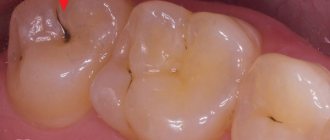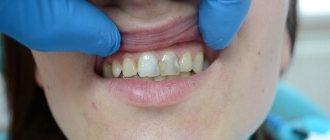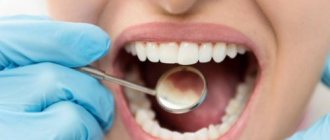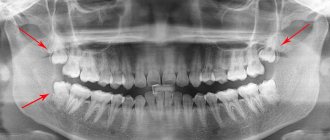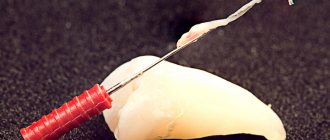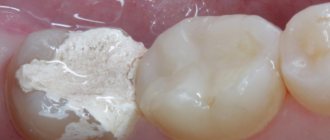Is caries treatment painful?
Many people are convinced that caries is painful to treat, and therefore are afraid to go to the dentist. The problem goes back to the recent past, when anesthetics were not used in dentistry. Just a few decades ago, no one could even imagine that it was possible to treat teeth with anesthesia, and all manipulations were performed “live.”
In this article
- Is caries treatment painful?
- Is it painful to treat dental caries with anesthesia?
- Is anesthesia always necessary?
- How to treat caries with an injection step by step?
- Is it painful to treat caries on the front teeth?
- What anesthesia is used in the treatment of caries?
- Who is contraindicated for anesthesia?
- Conclusion
Of course, with this approach it was very painful to treat deep caries and other stages of this disease that affected the sensitive parts of the tooth. Fortunately, dental treatment methods have changed, modern safe anesthetics have appeared, and it has become easier to treat with an injection.
Septanest (France)
They are produced in two forms with an adrenaline content of 1:100,000 and 1:200,000. Unlike Ultracaine and Ubistezin, the anesthetic contains preservatives that have a strong allergenic effect.
The drug Scandonest is produced based on mepivacaine. The anesthetic does not contain preservatives or vasoconstrictors. Recommended for anesthesia for pregnant and lactating women suffering from cardiovascular diseases, bronchial asthma and thyroid diseases.
Important. When visiting a dentist, be sure to tell the doctor if you have allergies or chronic diseases. This will help the doctor choose the right anesthetic for you.
Is it painful to treat dental caries with anesthesia?
If you treat caries with an injection, anesthesia will be given at one of the first stages of treatment. Once the tooth is frozen, it will no longer hurt. Thanks to anesthesia, tooth sensitivity will noticeably decrease, and even with deep and complex caries there will be no pain. You will feel the touch of dental instruments, perhaps minimal discomfort, but not pain. When the treatment is completed and the anesthesia wears off, your gums will hurt a little for a while after the injection. But this feeling is tolerable and will soon pass.
There are people with intolerance or allergic reactions to anesthesia for whom injection pain relief is not suitable. This does not mean that they will have to endure pain when treating dental caries. For such patients, modern dentistry can offer an alternative painless treatment method - for example, using chemical dissolution of the affected tissue or using a laser.
Complications
Teeth do not heal on their own. In any case, you will have to see a doctor, but it is better to do this as soon as possible. If it so happens that for some reason you have delayed this process, be prepared for the fact that caries will turn into pulpitis or periodontitis.
The pain in such cases becomes unbearable - throbbing, pulling, almost incessant. At a certain point, the patient will not even be able to tell which tooth hurts, since the pain can take over the entire jaw and radiate to the eye, ear, and temple.
Is anesthesia always necessary?
When treating caries, there is not always a need for an anesthetic injection. It depends on how badly the tooth is damaged and the individual sensitivity of the patient.
Superficial caries.
For example, early caries on the surface of the teeth resembles a whitehead and can be treated in a non-invasive, painless way. To do this, a procedure is carried out to remineralize the enamel. It is coated with special protective compounds and electrophoresis is performed with fluorine or calcium ions. This method of treating teeth does not hurt at all, so the doctor does not even offer pain relief with an injection.
Average caries.
At this stage, the carious process reaches the upper part of the dentin - the connective tissue under the tooth enamel. At this stage, drilling may be painful, but for many it is tolerable. Therefore, treatment of average caries can be carried out both with and without an anesthetic injection - it depends on the individual threshold of sensitivity and the wishes of the patient.
Deep caries.
This is the most complex form of pathology. If the caries is deep, then the dentinal tubules with nerve endings are involved in the process, and any touch causes pain. It is very painful to treat teeth without anesthesia at this stage, so in most cases the area around the affected tooth is numbed with an injection.
In addition to the degree of tooth decay, the intensity of pain can be influenced by the location of the caries. The lateral one is located on the side of the tooth, away from the neck and, as a rule, does not cause severe pain. The contact tooth is located at the junction of two teeth, and the severity of pain is comparable to average caries. To endure or to give an anesthetic injection depends on the patient’s choice. Cervical caries is located in the most sensitive root zone of the cervix, where many nerve endings are located. Almost always, cervical caries is treated with an anesthetic injection.
How to treat caries with an injection step by step?
At other stages of caries, teeth are treated approximately according to the same scheme, which includes several stages:
- Cleaning teeth.
The doctor removes tartar and plaque from the surface of the tooth being treated.
- Selecting the shade of the filling.
The dentist selects the material for filling, focusing on the natural color of the enamel of the damaged tooth. To do this, he uses the so-called Vita scale - a plastic strip with samples of different shades.
- Anesthesia.
Anesthesia injections help make the procedure painless and reduce discomfort during the treatment of caries. The type of drug and dose are selected taking into account the age and individual characteristics of the patient. The anesthesia usually lasts from 40 minutes to several hours. Sometimes the gums hurt a little after the injection, but this does not compare with the pain when treating deep caries without anesthesia.
- Isolation of the tooth before treatment.
It is performed by placing a small plate - a rubber dam - on a row of teeth. As a result, one or more necessary teeth are completely isolated from the others. This allows the dentist to do a better job and prevent blood and saliva from getting on the cleaned surface, which guarantees its reliable connection to the filling in the future.
- Preparation of a carious cavity.
Cleansing the tooth of all tissues that have been damaged by caries and parts of the tooth enamel above the carious cavity. If you leave the caries at least partially and install a filling, after a couple of months the problem may recur. And in the future complications may develop - pulpitis and periodontitis.
- Formation of a carious cavity.
The doctor creates the best conditions for installing the filling by forming special support points. It makes indentations, notches, irregularities in the cavity, and smoothes the edges of the enamel. This is required for the filling to fit tightly to the walls of the tooth.
- Washing the cavity.
After the above procedures, the carious cavity is washed and sprayed with a stream of air to remove dentin sawdust.
- Medical treatment of carious cavity.
It is produced using antiseptic solutions to prevent the new development of caries. Then the doctor dries the cavity well so that drops of moisture do not interfere with the close contact of the filling with the tooth tissues.
- Acid etching.
It is performed so that the adhesive, which is applied after etching for a stronger fixation of the filling material, can penetrate deeper into the dental tissue. To do this, use a special gel with phosphoric acid. After etching, the gel is washed off well and the tooth is dried.
- Application of adhesive.
It is applied to the tooth to firmly fix the light-curing filling material; after absorption, it is illuminated using a special lamp.
- Application of a therapeutic and insulating pad.
This step can be performed either before or after acid etching. Spacers are an intermediate layer between the dentin or pulp and the filling material. Therapeutic pads protect the tooth from external adverse influences and help stop inflammation; they are most often used to treat deep caries. Isolating gaskets protect the pulp, the soft connective tissue of the tooth, from the negative effects of filling materials.
- Placing a filling.
The doctor takes turns, layer by layer, applying filling materials and drying each of them with a dental lamp.
- Grinding, polishing.
The restored tooth with filling is ground and polished to perfect smoothness and evenness. This gives it a natural shine and eliminates the smallest imperfections and gaps that cause inconvenience. At this stage, caries treatment ends. Thus, anesthesia with an injection is given at the very beginning of dental treatment, and all other stages are absolutely painless for the patient.
Is it painful to treat caries on the front teeth?
Due to their location and structural features, caries on the front teeth is more difficult to treat. If the damage is severe, it is not always possible to put a filling, and then you will have to resort to prosthetics.
There are other features:
- The front teeth, compared to molars and premolars, have thinner and more sensitive enamel. It is easily destroyed, opening access to sensitive dentin, so the central incisors are more sensitive to pain.
- The front teeth, which are used for gripping and cutting food, are subject to high stress and wear out more quickly.
- A large cavity is often hidden under a small chalk point. And often caries is detected already at the stage when it is difficult to cure without pain. Therefore, in most cases, anesthesia is used in the treatment of caries of central incisors.
- Increased aesthetic demands are placed on the front teeth, so the filling must be placed not only reliably, but also beautifully.
That is why the condition of the front incisors - teeth with a small chewing surface area - must be monitored especially carefully.
If caries affects the front teeth, due to the thin enamel and dentin, it very quickly passes into the middle and deep stage, affecting the sensitive pulp. If you do not know whether it is painful to treat deep caries of the front teeth and doubt whether you need anesthesia, we recommend that you definitely agree to an anesthetic injection. Of course, in the absence of contraindications to the anesthetic. Because treating caries on the front teeth is painful.
What anesthesia is used in the treatment of caries?
To remove tooth sensitivity and treat it painlessly, the dentist selects the appropriate type of anesthesia for each patient.
The most common are three types - application, infiltration and conduction:
- Application involves pain relief without injections. A gel or solution of an anesthetic is applied to the oral mucosa, which reduces the sensitivity of the tissues in this area. Most often, topical anesthesia is performed when treating or removing baby teeth. It is also used to numb the injection site.
- Infiltration is anesthesia with an injection of an anesthetic, which is injected relatively shallowly and affects the peripheral nerves. This type of anesthesia is often performed in the treatment of caries and pulpitis. After the injection, the patient does not feel pain and feels comfortable in the dental chair.
- Conduction anesthesia acts on large nerve canals and trunks. With its help, you can remove the sensitivity of half the jaw. It can be used for caries, which is complicated by a serious inflammatory process, during surgery.
The type of anesthesia, as well as the drug used to numb the teeth, is selected by the dentist.
When to see a doctor, symptoms
Don’t delay going to the dentist if you suddenly experience even minor pain. The very fact of pain indicates that caries has begun to develop, which in some cases affects the tooth almost instantly.
When to go to the doctor:
- pain when biting;
- pain from temperature and chemical irritants;
- pain from exposure to cold air.
Without a doubt, the best option is to visit your dentist once every six months in order to take timely measures to prevent the development of caries.
Who is contraindicated for anesthesia?
There are three main contraindications to the use of local anesthetics during dental treatment in the clinic:
- Pathologies of the cardiovascular system (stroke and heart attack, after which less than six months have passed).
- Endocrine diseases in the stage of decompensation - thyrotoxicosis, diabetes mellitus. It is recommended that patients of the first and second groups treat caries and other dental diseases only in a hospital.
- Allergic reactions to anesthesia and anesthetic components. In this case, it is recommended to conduct allergy tests and find out which drugs you are allergic to. If it is selective, caries can be treated with an anesthetic injection - but only one to which you are not allergic. If the tests show a reaction to all anesthetics, you will have to treat your teeth without pain relief or look for alternative options. Sometimes the solution for allergy sufferers may be sedation, which puts a person into a state of half-asleep and partially disables reactions. In this state, the pain is felt much less.
Ultracaine
French drug, available in 1.7 ml carpules in three forms:
- Ultracaine DS forte
– containing 1:100,000 epinephrine. A highly effective anesthetic for operations and treatment of pulpy teeth. Not recommended for patients with thyroid diseases and cardiovascular pathologies. - Ultracaine DS
- with an epinephrine concentration of 1:200,000. Ideal for pain relief in pregnant and lactating women and patients with compensated cardiovascular diseases. - Ultracaine D
– without adrenaline/epinephrine. Used when there is a high risk of allergic manifestations. Can be used by patients with bronchial asthma, cardiovascular pathologies, and thyroid diseases.
The drug can be used starting from the age of four.

